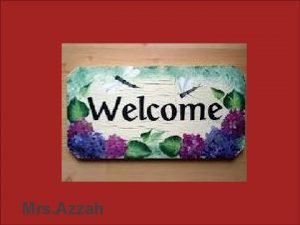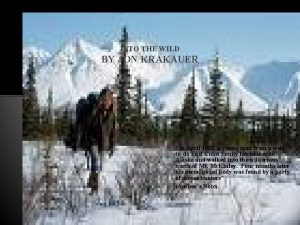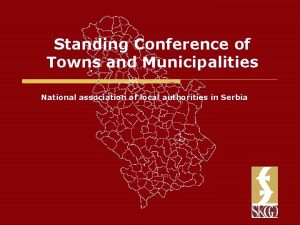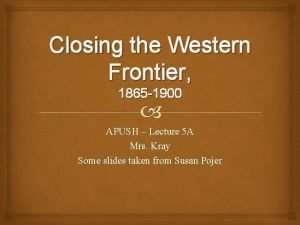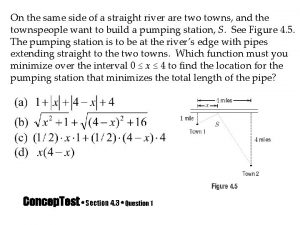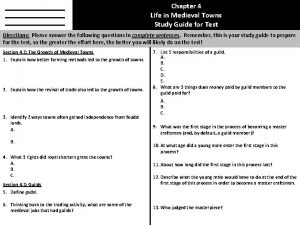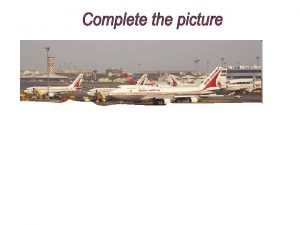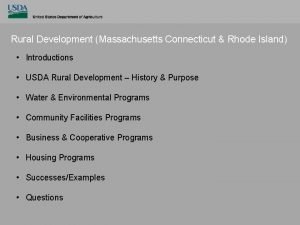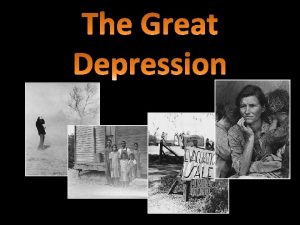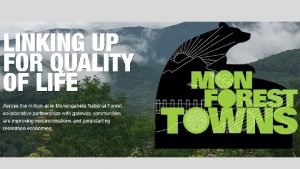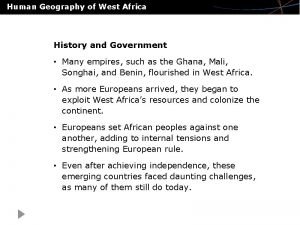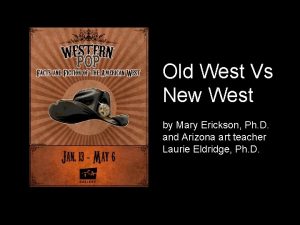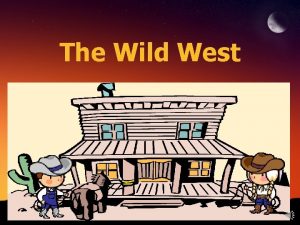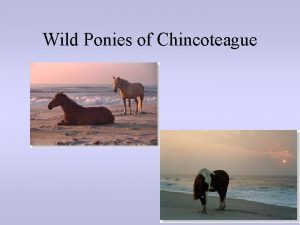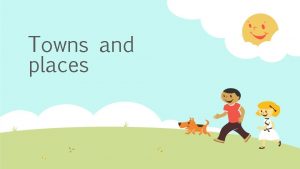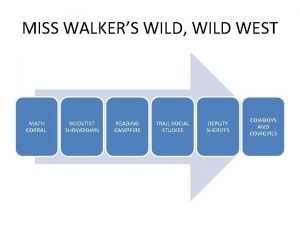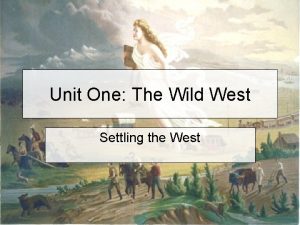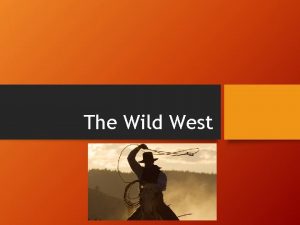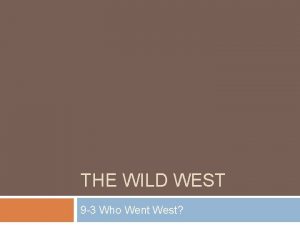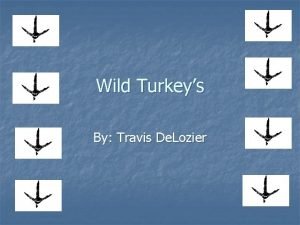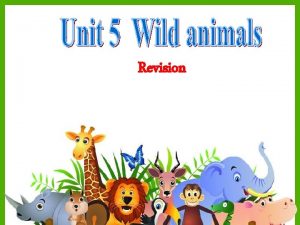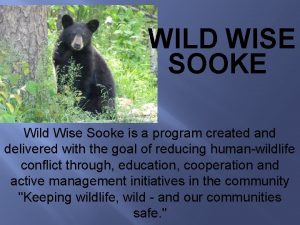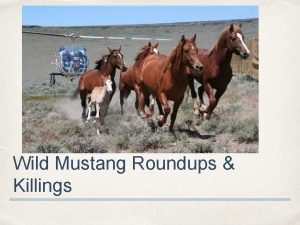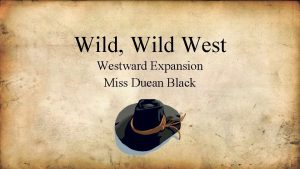The Wild West Geography of the West Towns






















- Slides: 22

The Wild West

Geography of the West ◊ Towns in Missouri were thought to be the end before the frontier ◊ Frontier – unsettled land in western United States ◊ The West is considered states beyond the Rocky Mountains like Oregon, California, etc. ◊ There are deserts, mountains, rivers, lakes, basins, plateaus, mesas, & even a volcano in the West

The Internet of the 19 th Century

Influence of Railroads ◊ Railroads helped settle the West ◊ Trains carried resources like: minerals, timber, crops, & cattle to the East coast ◊ Trains also carried miners, ranchers, & farmers to settle the West ◊ Trains & Native Americans – not friends • Train routes often went through the routes of the animals they hunted or even through their own lands

Transcontinental Railroad ◊ In 1862, the Pacific Railroad Act chartered the Central Pacific and the Union Pacific Railroad Companies, and tasked them with building a transcontinental railroad that would link the United States from east to west. Over the next seven years, the two companies would race toward each other from Sacramento, California on the one side and Omaha, Nebraska on the other, struggling against great risks before they met at Promontory, Utah, on May 10, 1869. ◊ History Video

Go West, Why? ◊ Before the Civil War, the South did not want the land in the West settled • They feared more non-slave territories ◊ Government decided it was time to settle the west by offering free land ◊ Homestead Act – You can have 160 acres for free if you live on it for 5 years and improve it ◊ Many African Americans settled in Kansas, Missouri, Indiana, & Illinois after the Civil War ◊ The Railroads were growing • It’s easier to head west

Challenges in the West ◊ Many challenges faced the people who moved West • There were no trees, so houses were built from sod (thick grass) • Had to dig wells for water • Blizzards, hailstorms, tornados, fires, drought • Insects ate crops ◊ New inventions helped some of the challenges • Steel plow – helped farming & built sod houses • Windmills – helped pump water from wells • Barbed wire – kept cattle in or out • Reapers & threshers – helped harvest crops

Mining in the West ◊ Gold has struck again in Nevada, Colorado, & South Dakota ◊ People raced to go to these areas ◊ Boomtowns appeared due to gold strikes ◊ Boomtown – a town that has a sudden burst of population & economic growth ◊ When the gold & other mined resources ran out people moved to the next town ◊ Boomtowns became ghost towns

Cattle Drives ◊ Cattle ranching made big money for 20 years ◊ Ranchers hired cowhands to drive cattle from Texas to Kansas ◊ Vaqueros – 1 st cowhands came from Mexico ◊ Cattle was put on trains & sent east ◊ Cattle driving was very difficult - you had to keep the cows or “the money” together ◊ Obstacles were: nature, thieves, & Native Americans

Native American Life ◊ Most Plains tribes lived in villages ◊ The Spanish brought horses in the 1500’s to the Native Americans & changed their way of life ◊ Horses helped travel & hunting buffalo ◊ All parts of the buffalo were used: food, clothing, blankets, tools, jewelry, etc. ◊ Now Native Americans could travel with the buffalo

The Government Lies ◊ The Native Americans were promised no one would take their land (White-man lies) ◊ When the settlers kept whining they wanted more land the government broke their promise ◊ The government set up “boundaries” or “reservations” for the Native Americans ◊ Some Native Americans went along with this while others resisted • Sand Creek Massacre – The Cheyenne fought back & the militia killed 150 tribe members

Native American Leaders ◊ Sitting Bull & Crazy Horse – Sioux chiefs who tried to push settlers off their land ◊ Chief Joseph – Nez Perce chief said, “It makes my heart sick when I remember all the good words and all the broken promises. ” ◊ Geronimo – an Apache leader who resisted to being put on a reservation ◊ No matter how hard they tried, unfortunately the Native Americans ended up on reservations anyway

Dawes Act ◊ There were people who actually believed what we had done to the Native Americans was wrong ◊ An idea of assimilation was discussed as a way for Native Americans to “fit in” to white culture ◊ Dawes Act – encouraged Native Americans to give up their customs to become farmers on reservations • Not all Native Americans wanted to be farmers • If they did want to be farmers, they weren’t given the tools or technology the white man had, so it was very difficult

Women in the West ◊ Life was challenging for women in the West • Life was lonely due to few neighbors & women did not go into town with the men • Women were doctors, nurses, cooks, mothers, teachers, & responsible for the homestead • Homestead – a piece of land & the house on it • The Western states acknowledged the importance of women ◊ Wyoming was the first state to fight for women’s right to vote ◊ Soon after Colorado, Utah, and Idaho stood up for women too

Western Cities ◊ Cities grew for a few reasons • Gold & precious mineral strikes • A “refueling” or supply renewal point • Railroad stops ◊ Many cities did not have formal laws or government • Cities & towns were rough • Some people took the law into their own hands • Vigilantes made their own rules

More of the Famous Ones… ◊ Billy the Kid • Billy the Kid was born William Henry Mc. Carty Jr. on November 23, 1859 in New York City. Little is known of his youth, but early on he entered a life of thievery, eventually heading west and joining a violent gang. Billy was captured and sentenced to death for the murder of a sheriff, but escaped after killing guards. The legend of Billy the Kid was created by his killer, Sheriff Garrett.

More Famous Ones… ◊ Wyatt Earp • Gunfight at the OK Corral ◊ Buffalo Bill ◊ Annie Oakley ◊ Calamity Jane ◊ Jesse James ◊ Wild Bill Hickok ◊ Josiah Gordon “Doc” Scurlock ◊ John Henry “Doc” Holliday ◊ Butch Cassidy ◊ Pearl Hart ◊ Sundance Kid ◊ The Apache Kid

Don’t Forget Us ◊ There were many groups of people who helped make the West what it is today • Vaqueros – the 1 st cowhands from Mexico • African Americans – cattle ranchers & western army soldiers • Chinese immigrants – builders of the railroad in the West • Native Americans – promises broken & forced to leave their homes • Pioneers – all those crazy, um, I mean brave people who took a chance

Closing the Frontier ◊ Fenced in fields replaced open plains ◊ In Oklahoma thousands of people rushed at the sound of a gun shot to claim land for themselves – 2 million acres were sold ◊ The frontier meant opportunity for many • You could make something of yourself if you moved West • You could start a new life • A good day - was a day of good, hard work

How the West has influenced us today… ◊ Cowboy boots & hats ◊ ◊ ◊ ◊ Blue Jeans Leather goods (bags, coats, vests, suspenders, etc. ) Home remedies (Hiccups – drink water while standing on your head) Saddles Stories (Buffalo Bill, Calamity Jane, Jesse James) movies, books, poems, songs Railroad growth & travel Food - apples, potatoes, salt water taffy Activities – rodeos, card games, bull riding Patterned clothing Treasure hunts Pony Express – the 1 st post office Bandanas

Slang of the “Wild West” ◊ ◊ ◊ ◊ ◊ Big Bug - - an important person Coffee boiler - - a lazy person Dude - - a person from the East Fandango - - a big party Fetch - - Bring or give Fork over - - to pay Fuss - - disturbance Get a wiggle on - - hurry up Grand - - excellent beautiful Hobble your lip - - be quiet Howdy - - hello In apple pie order - - in tip top shape Jig is up - - it is over Pass the buck - - to avoid responsibility Pull in your horns - - Back off! Skedaddle - - RUN! Stumped - - confused

Sources ◊ History. com ◊ Bon Jovi, “Dead or Alive” Greatest Hits ◊ Garcia, Jesus, et. al. (2003). Creating America. Chapter 19 Sections 1 -4. Mc. Dougal Littell. Evanston, Illinois. ◊ Atwater, G. M. “Western Slangs & Phrases. ” A Writer’s Guide to the Old West. October 26, 2006. April 21, 2007. http: //freepages. genealogy. rootsweb. com/~poindexterfamily/Old. W est. Slang. html
 Wild west geography
Wild west geography Wild born
Wild born Wild sweet pea vs wild potato
Wild sweet pea vs wild potato Standing conference of towns and municipalities
Standing conference of towns and municipalities Towns near dedham ma
Towns near dedham ma Elmer towns
Elmer towns Kiawah island police
Kiawah island police Deadwood sd apush
Deadwood sd apush On the same side of a straight river are two towns
On the same side of a straight river are two towns Life in medieval towns answer key
Life in medieval towns answer key Disadvantages of shanty towns
Disadvantages of shanty towns Usda approved towns in massachusetts
Usda approved towns in massachusetts Vital villages thriving towns introduction
Vital villages thriving towns introduction Hoover towns
Hoover towns Hpact
Hpact Dr sujan ali
Dr sujan ali Mon forest towns
Mon forest towns Proruption ap human geography
Proruption ap human geography Ap human geography frqs
Ap human geography frqs 5 themes of geography ap human geography
5 themes of geography ap human geography Human geography of west africa
Human geography of west africa Physical geography of west africa
Physical geography of west africa Old west vs new west
Old west vs new west

